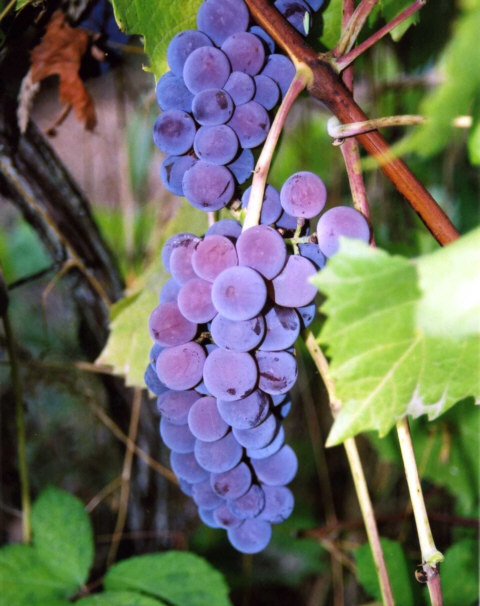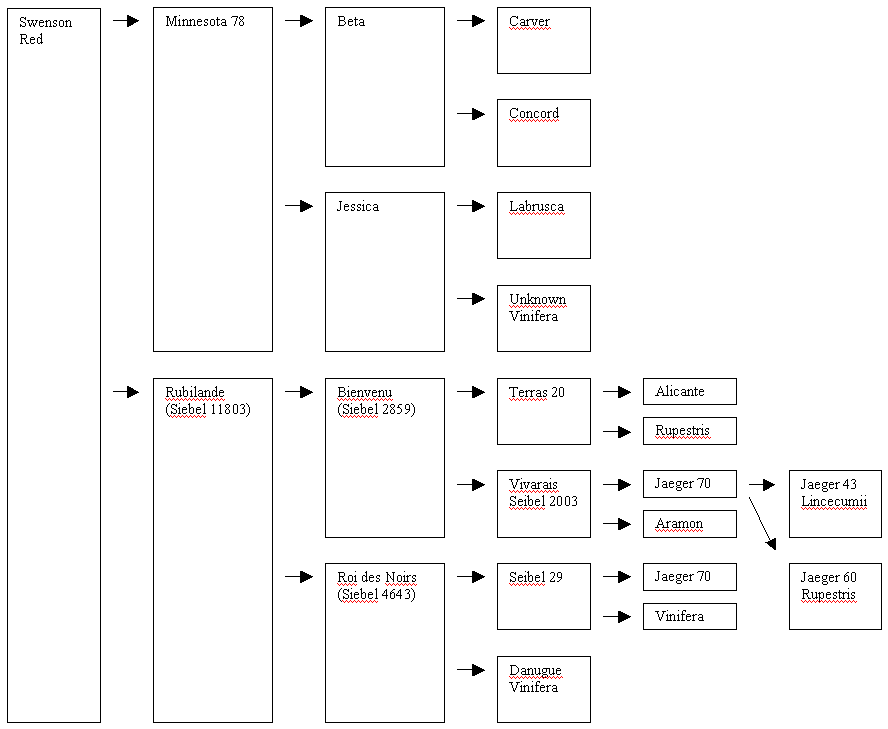
Grapebreeders Home Page
Swenson Red
Photo & text by Lon Rombough
When Elmer Swenson in northern Wisconsin (Osceola)
set out to breed grapes for his cold climate, he wanted something better than
the labrusca style varieties that were available then - things like Worden and
Beta that were too "foxy" for his tastes. One of the grapes he acquired
to use in breeding was Seibel 11803, a French Hybrid with very crisp, vinifera-like
berries.
However, it was so cold tender that even when
the vine was buried to protect it from the cold, it still died back so much
that it didn't bloom. Finally, after several attempts to get it to survive long
enough to bloom, Elmer got a couple of flower clusters and used the pollen from
them on hardy female flowered grapes.
One of those was Minnesota #78, a seedling of
Beta from the University of Minnesota grape breeding program of the 1930's.
From that cross, three selections were made and one selection in particular
stood out - the one that became Swenson Red. Firm, meaty, with a
unique, fruity flavor that was completely unlike the typical labrusca flavored
types, this was the grape Elmer had been seeking - a grape that was more like
vinifera than any other cold hardy grape to that time.
Hardy to about -30 deg. F when well hardened,
Swenson Red isn't always red. That is, the color pigments in it are temperature
sensitive and in climates where nights are cool, the color may be nearly blue,
while where nights are hot, the fruit can be completely green in color even
when fully ripe. The flower clusters occasionally fail to pollinate in the center
area, resulting in a dumbbell shaped cluster, though this rarely happens to
more than a quarter of the clusters.
Ripening time averages about a month before Concord,
or about mid September in Wisconsin and for me, in Oregon. Sugar is fairly high,
often 21 degrees Brix, which is high enough that some growers report being able
to make an acceptable white or rose wine from it. Personally, I can't bear the
idea of using it for anything but eating. The vines like fertile soil for best
vigor and productivity, though they will do well in other soils.
Often, the vines will seem lacking in vigor for
several years, but after a time they seem to reach a "take off" point
and the vigor and productivity will increase all of a sudden one year and the
vines do better after that. This is an inherited trait as seedlings of Swenson
Red often behave the same way. The leaves are shiny and free of pubescence,
making Swenson Red an attractive vine for a high visibility area. Also, the
leaves are good for stuffed grape leaves, though it's a good idea to wait until
the vine is vigorous and well matured before using many of the leaves.
Elmer, and other growers, report that Swenson
Red gets downy mildew in bad years, and needs to be watched for that. How good
is the fruit? All I can say is that it usually places in first or second place
in tastings. It is worth noting that there was another seedling from the same
cross, Elmer's selection #417, that has much of the same character as Swenson
Red. A white grape, it wasn't named or officially released because it has female
flowers and requires a pollinator. In my collectiion it tastes much like Swenson
Red, but with more acid.
Copyright 2001 - Lon J. Rombough
No reprinting without permission of the author

Swenson Red cluster.

Editor Soeren Larsen